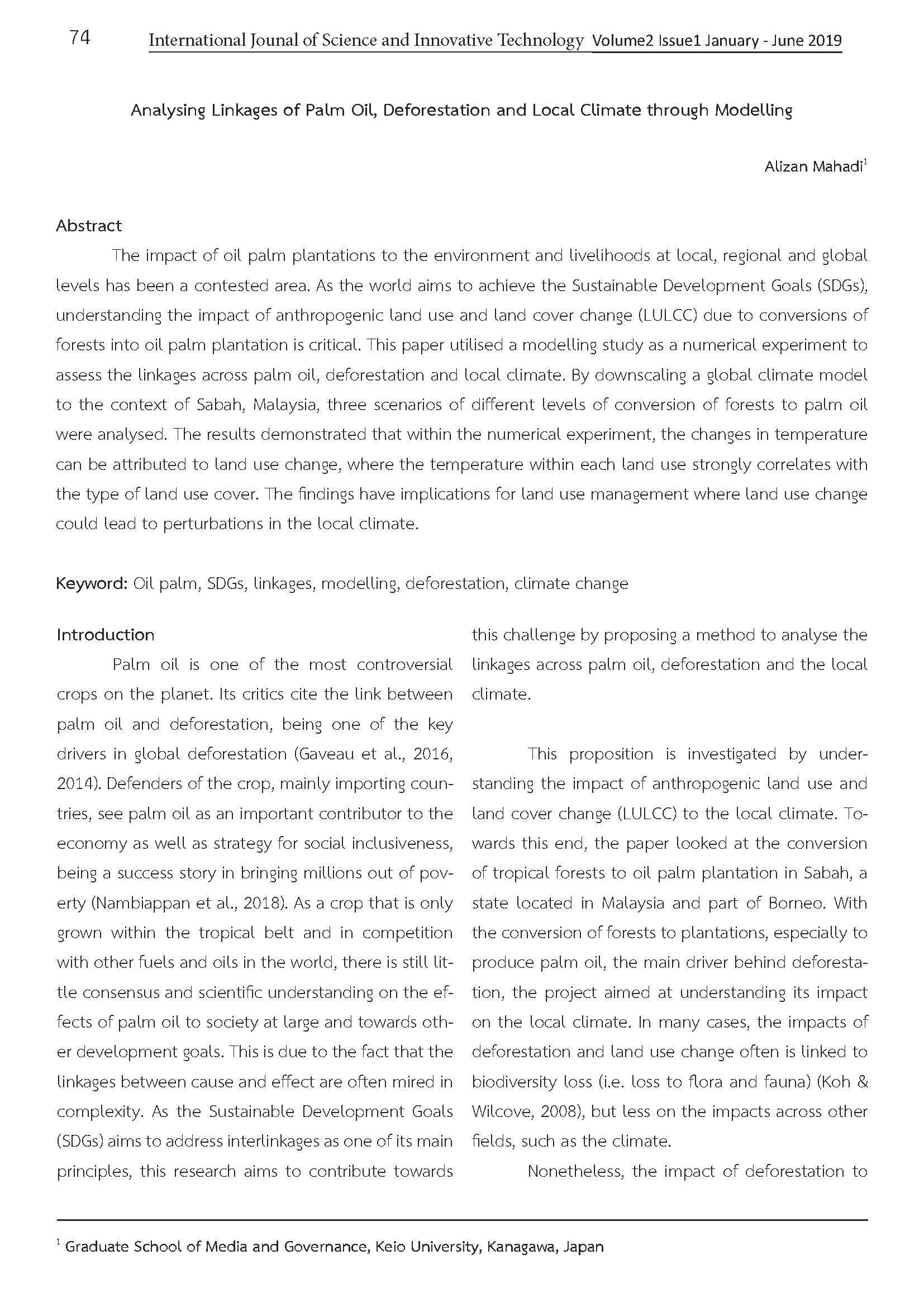Analysing Linkages of Palm Oil, Deforestation and Local Climate through Modelling
Main Article Content
Abstract
The impact of oil palm plantations to the environment and livelihoods at local, regional and global levels has been a contested area. As the world aims to achieve the Sustainable Development Goals (SDGs), understanding the impact of anthropogenic land use and land cover change (LULCC) due to conversions of forests into oil palm plantation is critical. This paper utilised a modelling study as a numerical experiment to assess the linkages across palm oil, deforestation and local climate. By downscaling a global climate model to the context of Sabah, Malaysia, three scenarios of different levels of conversion of forests to palm oil were analysed. The results demonstrated that within the numerical experiment, the changes in temperature can be attributed to land use change, where the temperature within each land use strongly correlates with the type of land use cover. The findings have implications for land use management where land use change could lead to perturbations in the local climate.
Article Details
References
Ashworth, K., Folberth, G., Hewitt, C. N., & Wild, O. (2012). Impacts of near-future cultivation of biofuel feedstocks on atmospheric composition and local air quality. Atmospheric Chemistry and Physics, 12(2), 919–939. https://doi.org/10.5194/acp-12-919-2012
Avila, F. B., Pitman, A. J., Donat, M. G., Alexander, L. V., & Abramowitz, G. (2012). Climate model simulated changes in temperature extremes due to land cover change. Journal of Geophysical Research Atmospheres, 117(4), 1–19. https://doi.org/10.1029/2011JD016382
Avissar, R., & Werth, D. (2005). Global Hydroclimatological Teleconnections Resulting from Tropical Deforestation. Journal of Hydrometeorology, 6(2), 134–145. https://doi.org/10.1175/JHM406.1
Boisier, J. P., De Noblet-Ducoudré, N., Pitman, A. J., Cruz, F. T., Delire, C., Van Den Hurk, B. J. J. M., … Voldoire, A. (2012). Attributing the impacts of land-cover changes in temperate regions on surface temperature and heat fluxes to specific causes: Results from the first LUCID set of simulations. Journal of Geophysical Research Atmospheres, 117(12), 1–16. https://doi.org/10.1029/2011JD017106
Bonan, G. B. (2008). Forests and Climate Change: Forcings, Feedbacks, and the Climate Benefits of Fiorests. Science, 320(5882), 1444–1449. https://doi.org/10.1126/science.1155121
da Silva, R. R., Werth, D., & Avissar, R. (2008). Regional impacts of future land-cover changes on the Amazon basin wet-season climate. Journal of Climate, 21(6), 1153–1170. https://doi.org/10.1175/2007JCLI1304.1
Davin, E. L., & de Noblet-Ducoudre, N. (2010). Climatic impact of global-scale Deforestation: Radiative versus nonradiative processes. Journal of Climate, 23(1), 97–112. https://doi.org/10.1175/2009JCLI3102.1
Gaveau, D. L. A., Sheil, D., Husnayaen, Salim, M. A., Arjasakusuma, S., Ancrenaz, M., … Meijaard, E. (2016). Rapid conversions and avoided deforestation: Examining four decades of industrial plantation expansion in Borneo. Scientific Reports, 6(June), 1–13. https://doi.org/10.1038/srep32017
Gaveau, D. L. A., Sloan, S., Molidena, E., Yaen, H., Sheil, D., Abram, N. K., … Meijaard, E. (2014). Four decades of forest persistence, clearance and logging on Borneo. PLoS ONE, 9(7), 1–11. https://doi.org/10.1371/journal.pone.0101654
Hardwick, S. R. (2015). Interactions between vegetation and microclimate in a heterogeneous tropical landscape.
Koh, L. P., & Wilcove, D. S. (2008). Is oil palm agriculture really destroying tropical biodiversity? Conservation Letters, 1(2), 60–64. https://doi.org/10.1111/j.1755-263X.2008.00011.x
Nambiappan, B., Ismail, A., Hashim, N., Ismail, N., Shahari, D. N., Idris, N. A. N., … Kushairi, A. (2018). Malaysia: 100 years of resilient palm oil economic performance. Journal of Oil Palm Research, 30(1), 13–25. https://doi.org/10.21894/jopr.2018.0014
Pielke, R. A., Pitman, A., Niyogi, D., Mahmood, R., McAlpine, C., Hossain, F., … de Noblet, N. (2011). Land use/land cover changes and climate: Modeling analysis and observational evidence. Wiley Interdisciplinary Reviews: Climate Change, 2(6), 828–850. https://doi.org/10.1002/wcc.144
Pitman, A. J., De Noblet-Ducoudré, N., Avila, F. B., Alexander, L. V., Boisier, J. P., Brovkin, V., … Voldoire, A. (2012). Effects of land cover change on temperature and rainfall extremes in multi-model ensemble simulations. Earth System Dynamics, 3(2), 213–231. https://doi.org/10.5194/esd-3-213-2012
Raupach, M. R. (1994). Simplified expressions for vegetation roughness length and zero-plane displacement as functions of canopy height and area index. Boundary-Layer Meteorology, 71(1–2), 211–216. https://doi.org/10.1007/BF00709229
Reynolds, G., Payne, J., Sinun, W., Mosigil, G., & Walsh, R. P. D. (2011). Changes in forest land use and management in Sabah, Malaysian Borneo, 1990-2010, with a focus on the Danum Valley region. Philosophical Transactions of the Royal Society B: Biological Sciences, 366(1582), 3168–3176. https://doi.org/10.1098/rstb.2011.0154
Running, S. W., Loveland, T. R., Pierce, L. L., Nemani, R., & Hunt, E. R. (1995). A remote sensing based vegetation classification logic for global land cover analysis. Remote Sensing of Environment, 51(1), 39–48. https://doi.org/10.1016/0034-4257(94)00063-S
Sabajo, C. R., Le Maire, G., June, T., Meijide, A., Roupsard, O., & Knohl, A. (2017). Expansion of oil palm and other cash crops causes an increase of the land surface temperature in the Jambi province in Indonesia. Biogeosciences, 14(20), 4619–4635. https://doi.org/10.5194/bg-14-4619-2017
Verhoef, A., McNaughton, K. G., & Jacobs, A. F. G. (1997). A parameterization of momentum roughness length and displacement height for a wide range of canopy densities. Hydrology and Earth System Sciences, 1(1), 81–91. https://doi.org/10.5194/hess-1-81-1997


